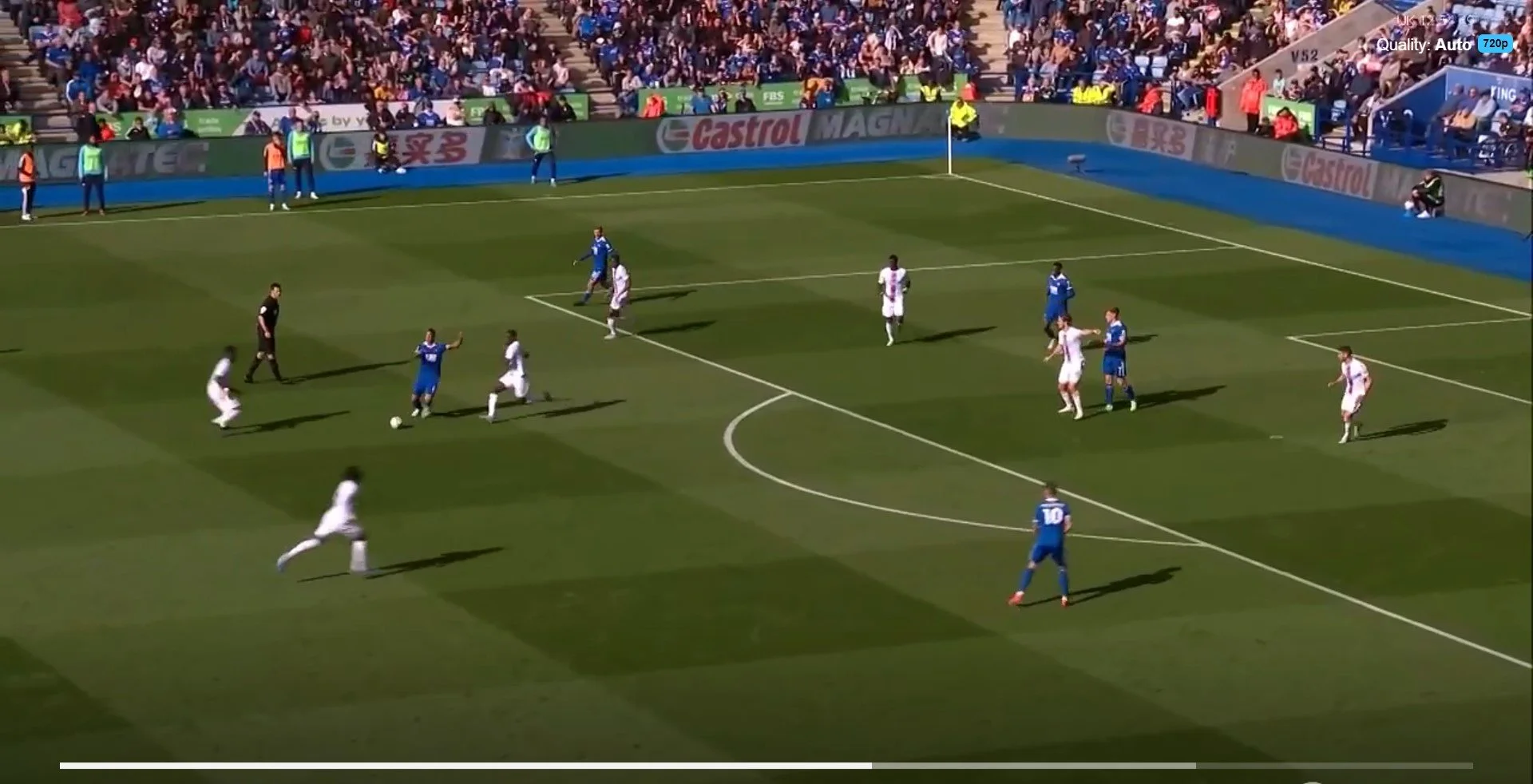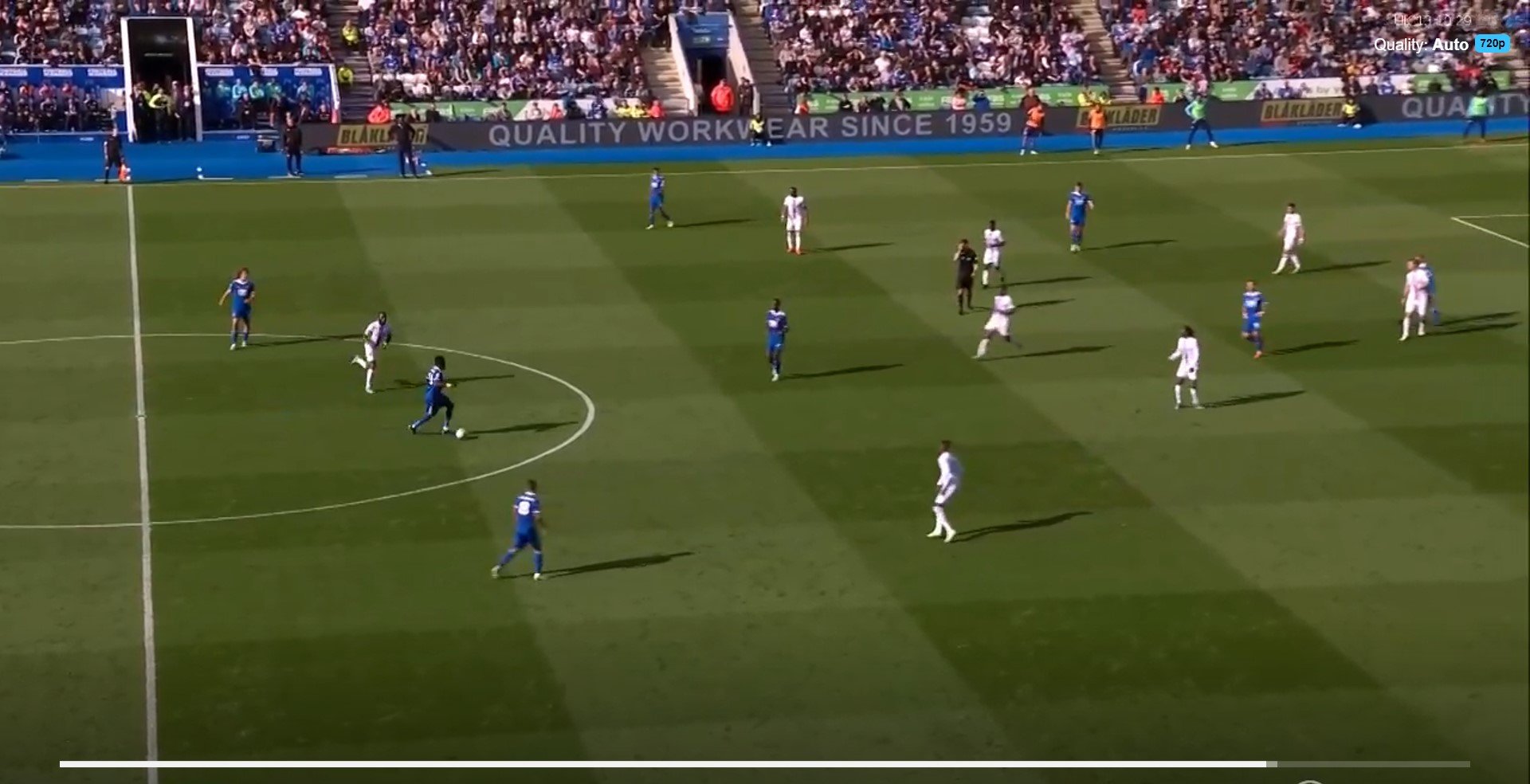TFW tactics club: A Tielemans tweak and the flat back five
There is a story about the Russian army in the Second World War, where a division comes to an impassable river and doesn’t have enough boats to cross. Rather than go a different way, the generals are so afraid of saying no to their superiors that they keep trying to march across the river until everybody drowns.
The popular narrative about Leicester’s start to the season is that Brendan Rodgers is one of those Russian generals. Bereft of ideas and with no one prepared to tell him otherwise, he’s ordering his players to do the same thing over and over again and getting the same result.
Saturday’s sweltering draw is a good opportunity to dive in and have a look at whether this is actually true. Is Rodgers trying to solve our problems, or holding our heads underwater and laughing all the way to the bank? Since the only thing better than watching a 0-0 draw at home is watching it twice, let’s dive in.
The lie of the land
Leicester’s biggest issue all season has been conceding goals. Letting in at least two goals a game is not going to get the job done. The game against Palace showed how Rodgers has attempted to solve this problem.
Rather than the blasé move of simply replacing the goalkeeper with one who makes some saves, he’s trying to reduce the number of shots we give up. This means using Youri Tielemans in a unique role and keeping more bodies back behind the ball.
We’ll look at how this works in a minute but first, a little refresher on what Leicester were doing before the international break.
The classic goal-conceding manoeuvre is the one we saw away at Brighton, when James Maddison, playing from the right, dropped deep into a central position and lost the ball. With no cover behind him, it was an immediate 3v2 breakaway and a simple goal. Leicester have given up so many chances like this, where we lose the ball and are suddenly wide open.
In that game, you may recall, Rodgers was in full windmill mode, so James Justin was at right back and Kelechi Iheanacho played alongside Patson Daka in a 4-4-2. Crucially, Tielemans was playing on the left of the midfield two, with Bouba Soumare to his right. Whenever Leicester lost possession, there were a lot of players ahead of the ball – the front four, plus Tielemans and often Justin wide on the right.
That Brighton game feels like the tipping point where Rodgers realised something had to change. Against Spurs the following week, Wout Faes made his debut and Wilfred Ndidi was restored to midfield. Tielemans went back to the right of him, and Kiernan Dewsbury-Hall played on the left of the midfield three. Timothy Castagne came in at right back and Justin moved over to the left.
An in-form Ndidi is a great defensive player but even on his best day he can be a liability in possession. At Spurs, Leicester wheeled out Tielemans in this new role, where he plays like a hybrid midfielder/right back to cover for Castagne’s forward runs. But taking him out of midfield put a lot of pressure on Ndidi’s ability on the ball, to disastrous effect right after half time.
Ndidi’s injury might have been a lucky break for Leicester because it’s forced Soumare in as his replacement. Soumare is a much better passer, and it has freed up Tielemans to play an extreme version of this right back job.
Right wing extremism
You may have heard that Leicester lack a quality right winger. As the season has developed, Rodgers has changed his focus from whining about that fact to using Maddison as a solution. This creates a secondary issue, because Maddison doesn’t really stay on the right at all, he’s a central attacking midfielder who occasionally stands on the right when the other team has the ball.
When Leicester have it, he is never anywhere near the right wing. What happens instead is that Castagne acts as the winger, routinely surging forwards to join attacks when Maddison comes inside. If Leicester lose the ball from there, there’s absolutely no protection on the right side of the pitch.
Enter Tielemans. The big mark against him has always been his lack of speed on the turn. When Leicester were good, playing him alongside Ndidi protected against that because the Nigerian had the physical traits to make up for it. In recent times, thanks to injury and the air of general hopelessness engulfing the club, we’ve seen it happen again.
This new role keeps the game in front of Tielemans and means Leicester have an extra body back to defend against the counterattack. This role asks a lot of his football intelligence and tactical ability. When Maddison and Castagne are in their “normal” positions, Tielemans stays in central midfield, but when Leicester commit men forward, he is a designated survivor. He breaks forward occasionally, usually with runs into the right corner, but he has to be sure it’s safe to do so otherwise the defence gets exposed on the break.
We can see a few examples of this plan working both defensively and in an attacking sense against Palace. Inside two minutes, Maddison comes central to get the ball while Castagne (in shadow) provides the width. Tielemans immediately drops in alongside Daniel Amartey - note how much closer together everyone is compared to Brighton.
This was the pattern throughout the whole game. Rarely did Castagne and Tielemans attack together. In fact, there is a pretty clearly defined split between the five “attackers”: KDH, Barnes, Maddison, Castagne, and Daka; and the five “defenders”: Justin, Faes, Amartey, Soumare, and Tielemans.
Here, Faes aggressively wins the ball back in midfield and lays it off to Soumare.
Previous editions of this team would have committed everyone forward at this point. Instead, Soumare moves forward, plays the ball out to the left wing and the five “defenders” all stay put. When Daka gets the ball, the three attacking midfielders are ahead of him, and Castagne is joining in down the right. Tielemans is clearly holding back.
This attack went nowhere, and the ball ended up back with Danny Ward, so it shows how there’s a trade-off. Leicester are still struggling to marry up carrying an attacking threat with being defensively solid. Ultimately, though, this caution is merited, even if it’s not ideal.
A similar situation plays out later in the first half, when Leicester work the ball out to Harvey Barnes on the left. The five “attackers” are there again, surrounded by white shirts.
Not surprisingly, Leicester are forced to recycle possession backwards (to the annoyance of the crowd). Where we have Tielemans again, on the right of a back three.
Despite the frustration in the stands, this patience was eventually rewarded with some nice attacking play. One of the attacking five, Dewsbury-Hall, overlaps down the left while the others make forward runs (Castagne’s head is in shot here bottom right).
Dewsbury-Hall ultimately ends up being fouled in the corner and winning a free kick. At which point Castagne was in the box waiting for a cross while Maddison – nominally the right winger – is on the left side of the penalty area.
The five attackers rule still held on the the rare occasions that Tielemans broke forward. In the middle of the first half, Patson Daka made a great run down the left to drag Leicester up, and Tielemans joins the front four.
He loses the ball here and Palace briefly threaten to get Zaha on the break down Leicester’s right. Had Castagne committed to add another body to the attack, this would have been very dangerous…but he hasn’t, and is on hand to intercept the through ball.
In this example, Leicester win the ball back and Tielemans goes back to Amartey. He immediately tells Castagne to get up the line.
And drops into the vacant right back spot. Which turns out to be crucial, because Amartey gon’ Amartey and Palace break into that space on the right. Thanks to his awareness, Tielemans is there to tackle Zaha and stop anything disastrous from happening.
After his tackle, Leicester break forward themselves and Tielemans effectively replaces Castagne on the right of the attacking five. He gets forward – eventually ending up in the box - while Castagne has stayed behind, a good example of the situational awareness both Belgians need to have for this to work.
Round pegs in roundish holes
To briefly credit Rodgers, this is a sign of trying to fix our defensive woes while also playing to individual strengths. Castagne is better as a wing back than a conventional full back, while Maddison needs a freer role because he just doesn’t fit into a modern system very well. Tielemans is a great passer with the game in front of him but can look hopelessly off the pace if he gets turned around.
On the 35-minute mark, we get another look into how the system works defensively. Initially, Maddison does well to press Palace into a mistake, Leicester feed Daka and break forward in transition. But Daka gives the ball away, the sort of mistake that has usually seen the Foxes pay the ultimate price throughout the whole of 2022.
This time that doesn’t happen. Only the five “attackers” broke forward when Maddison won the ball and when Palace countered themselves, Tielemans dropped in as a right back to cover for Castagne’s run. Justin – notably – rarely broke forward to join attacks on the other side, instead staying much deeper to form a line like this. We have Tielemans – Soumare – Justin offering a layer of protection in front of the centre backs.
As the Palace attack is forced to slow down, Leicester can quickly get numbers back to prevent any disasters. A few seconds later, Justin has gone to press the ball; Dewsbury-Hall – who has the stamina to make these recovery runs - has got back into position to form a shield with Soumare; Tielemans is still at right back and Castagne is basically in the right-wing role.
Maddison, meanwhile, is nowhere to be seen. When Leicester lost the ball he more or less stopped playing, which is partly why Leicester have to set up like this and why he doesn’t get picked for England.
Pass and move
The other benefit to having Tielemans so deep is that it’s helped with Leicester moving the ball forwards. We have all seen hundreds of games where the centre backs spend an hour or so passing the ball among themselves. Not only is he obviously a much better passer than the defenders in general, the Belgian is outstanding at finding passes to break the lines.
During Leicester’s best spell of the first half, we see this shape in possession manifest itself again. Maddison is in central midfield and Castagne is wide on the right. Tielemans drops into the right back spot and plays an unbelievable left-footed ball that takes seven Palace players out of the game.
Dewsbury-Hall ultimately fed Daka, whose first time shot went out for a corner. This is something to look out for against Leeds: if Leicester can break the Leeds press there is going to be a lot of space for the attackers to work with. Kelechi Iheanacho (if he plays) is very good at receiving the ball to feet and the Tielemans –> Iheanacho supply line could be profitable.
Right at the end of the first half, the threat of that passing ability leads to Leicester’s best chance. This time, Tielemans drops in between Amartey and Faes, while Castagne (who has just played the ball to Amartey here) bursts up the right. Maddison has come in off the right into central midfield, Eze has tracked Tielemans’ move back, and suddenly a passing lane opens up for Amartey. The holding midfielder, Doucoure, is forced to choose between closing down Maddison or tracking Castagne’s run down the right.
Maddison suddenly has a huge amount of space, and the five attackers are all charging forward again.
This attack started out with Leicester passing it around on the edge of their own area and we’ve created a 5v5 break with one simple pass.
Rather than a through ball, Maddison chooses to slow the game down here. Justin ends up joining in from quite a central position (look at how deep Tielemans is) and crosses to Castagne at the back post.
Castagne mis-controls this and it goes harmlessly out of play but it’s a good example of Leicester’s shape and plan. This was one of the best chances of the game. If Castagne had got the ball down, he would have been in a great spot to square for Daka, cut back to Maddison, or shoot himself. And it all came from being able to move the ball quickly and having better passing from deeper areas.
A glorious future?
Palace are not as good as Brighton or Spurs, but we’ve seen throughout the season that the opposition doesn’t need to be good to generate chances against Leicester. The wounds are almost always self-inflicted.
This set up produced the most solid performance of the season. While Leicester dominated against Notts Forest, we gave up a few really good chances and the tricky trees proved too hapless to take advantage. Palace created nothing. Leicester meanwhile, created some decent chances and a lot of ‘good situations’, where a bit of luck or a better final pass would have got one of the “front five” in.
Moving Tielemans into this new hybrid role is an acceptance of a dual problem: the fact that Leicester make a lot of individual errors, and the fact the whole team is often exposed as a result. It relies on the football intelligence of the two Belgians and restraint on the part of others - most notably Justin - but it did work against Palace.
The Leeds still game feels pivotal. It’s going to be hard to countenance more dropped points at home. But there are signs of progress here, despite the glaring lack of points to go with it. In the three games since the break there has only been one bad half. We are showing more solidity and control, at least when the games are in the balance. The next challenge is keeping it up when we go ahead…
Follow @TheFosseWay
-
Who should the new #LCFC manager be? No shouts for Martin O'Neill. But it was a chance for Jordan @BSLBPodcast to… https://t.co/gUna32lvth
-
RT @sj_b90: @TheFosseWay @beckytLCFC @IainW198 @BSLBPodcast @db_writing Play Madders behind Kele Start Ricardo RB WIN GAMES
-
RT @MeetTheCritics: @TheFosseWay @beckytLCFC @IainW198 @BSLBPodcast @db_writing 1. Play Maddison centrally and Ricardo right side 2. P… https://t.co/GSqWYScsqf





























